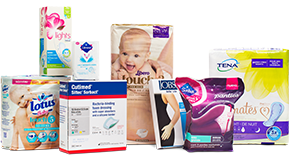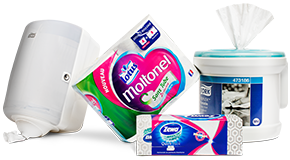The hygiene and health market
In 2018, the global hygiene and health market amounted to approximately SEK 1,210bn, of which the global market for personal care accounted for approximately SEK 620bn and the global market for tissue accounted for approximately SEK 590bn.
The global market for personal care is divided into baby care (approximately SEK 250bn), feminine care (approximately SEK 140bn), incontinence products (approximately SEK 100bn) and medical solutions (approximately SEK 130bn). The global market for tissue is broken down into consumer tissue (approximately SEK 440bn) and professional hygiene (approximately SEK 150bn).
Market growth is positively impacted by global hygiene and health trends and increased awareness of the importance of hygiene to avoid diseases and improve health.
Personal care market
Growth in consumption of personal care products is supported by favorable demographic trends in emerging and mature markets. Shifts in global demographics such as population growth and increased longevity as well as higher disposable income point to continued good growth for personal care. The effect of higher disposable income is that more people prioritize hygiene when food and housing needs have been, or are in the process of being, satisfied. The growth potential for personal care is greatest in emerging markets where market penetration is significantly lower than in mature markets and where urbanization, improved infrastructure and the retail trade are evolving rapidly. One example of the lower market penetration in emerging markets is that the consumption rates for incontinence products in Asia are only about one-sixth of those in Western Europe. In mature markets, baby care and feminine care have attained high market penetration. However, market penetration for incontinence products in mature markets is still relatively low for certain product segments, particularly among men, which Essity believes is due to lack of awareness and the stigma associated with incontinence.
Incontinence, which is classified as a disease by the World Health Organization (WHO), affects 4–8% of the world’s population, corresponding to approximately 400 million people. Many indicators point to the proportion of people affected increasing on a global scale as a result of an aging population. By 2020, the population of the world over the age of 60 is expected to have increased to over one billion. The occurrence of incontinence among people over the age of 65 is expected to be between 15 and 20%.
An aging population and increased prevalence of chronic conditions are expected to increase demand for incontinence products and medical solutions.
Essity’s competitors in personal care include Kimberly-Clark, Procter & Gamble, Unicharm and 3M.
Tissue market
Shifts in global demographics such as population growth and increased longevity as well as higher disposable income point to continued good growth for tissue. The effect of higher disposable income is that more people prioritize hygiene when food and housing needs have been, or are in the process of being, satisfied. The growth potential for tissue is considered greatest in emerging markets where market penetration is significantly lower than in mature markets and where urbanization, improved infrastructure and the retail trade are evolving rapidly. One example of the lower market penetration in emerging markets is that tissue consumption per capita per year in Eastern Europe is only about one-third of that in Western Europe. Growth is also occurring in mature markets owing to lifestyle changes and innovations that lead to increased use.
Essity’s competitors in tissue include Georgia-Pacific, Hengan, Kimberly-Clark and Sofidel.
The hygiene and health market
Global market by region
Personal Care
Essity’s market positions
Personal Care – global market
Use of incontinence products
Use of baby care
Use of feminine care

Consumer Tissue and Professional Hygiene
Essity’s market positions
Professional Hygiene – global market
Use of tissue
Consumer Tissue – global market

Source: The information has been compiled by Essity for presentation purposes based on statistics taken from external market sources, including IRI, Price Hanna Consultants and National Macro Economics.